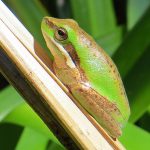CASCADE TREEFROG
Cascade treefrog -A night beside a cascade
Mist drifts off a rainforest stream, cool on the skin and scented with wet leaf litter and moss. Water slides over dark rock, murmuring in constant ribbons. From the ferny edges comes a gentle refrain—wark… wark… wark—soft notes repeating like beads on a string. Follow the sound and you may glimpse the Cascade treefrog, small and perfectly balanced on a slick boulder, its toe pads holding fast where the water flashes past.
Quick facts
| Feature | Detail |
|---|---|
| Size | 3–4 cm (snout to vent) |
| Colour | Green, brown, or grey; often mottled for camouflage |
| Range | Eastern Australia, mainly Queensland and New South Wales |
| Habitat | Rainforest and moist forests along clean, flowing streams and cascades |
| Activity | Mostly nocturnal; excellent climber with adhesive toe pads |
| Call | Soft, repetitive “wark-wark-wark” during breeding season |
| Status | Near Threatened (habitat loss, pollution, climate pressures) |
Identification
- Smooth skin with colours that mirror the forest—leafy greens, bark browns, and misty greys. Mottling is common and helps it vanish against lichen, leaves, and rock.
- Slender limbs tipped with wide adhesive toe pads for moving across wet leaves and polished stones.
- Typically a subtle, pale edging along the jawline and side; overall appearance is neat and streamlined.
Range and habitat
- Found along the eastern ranges and coastal foothills of Queensland and New South Wales.
- Strongly tied to cool, well-oxygenated streams within rainforest and wet sclerophyll forest.
- By day, they shelter among leaf litter, tree hollows, and dense vegetation close to water. At night, they move to stream edges, rocks, and low branches to feed and call.
Behaviour and diet
- Nocturnal insectivores, taking ants, beetles, moths, and other small invertebrates with a quick flick of a sticky tongue.
- Their climbing skill allows them to forage on dripping fern fronds and slippery boulders where spray keeps surfaces perpetually wet.
- When threatened, they freeze and rely on their camouflage; a still frog can be almost impossible to find among speckled leaves.
Breeding and life cycle
- Breeding peaks from spring to early autumn, often after rain.
- Males call from rocks, low shrubs, or stream banks with a soft, repeated “wark-wark-wark” that carries gently over running water.
- Females lay clusters of eggs attached to submerged vegetation or stones.
- Tadpoles develop in flowing water over several months, built for streams with strong tails and a steady grip as they graze on biofilm and algae. They metamorphose into tiny, well-camouflaged frogs that move into streamside cover.
Voice: what to listen for
- A low, rhythmic, and repetitive call—“wark-wark-wark”—often delivered in long series.
- Calls rise after dusk and on humid nights, weaving with the sound of the stream into a delicate chorus.
Ecological role
- Helps keep insect populations in balance.
- Provides food for birds, snakes, and larger frogs.
- Acts as a natural indicator of stream health; where Cascade treefrogs thrive, waterways are usually clean and intact.
Conservation status and threats
- Listed as Near Threatened due to:
- Habitat loss and fragmentation along rainforest streams.
- Pollution and sedimentation that reduce water quality.
- Altered flow regimes and the increasing stress of climate change.
- Disease risks such as chytridiomycosis.
- Introduced fish (e.g., Gambusia) that prey on eggs and tadpoles.
- Protecting intact riparian vegetation and maintaining clean, flowing water are central to the species’ survival.
How you can help
- Keep streams clean: prevent litter, chemicals, and sediment from entering waterways.
- Protect and restore riparian vegetation with native plants.
- Stay on formed tracks and avoid trampling stream edges.
- Disinfect boots and gear between waterways to reduce the spread of amphibian diseases.
- Support local conservation groups monitoring frog populations and water quality.
Similar species
- Part of a closely related group with the leaf green treefrogs. Visual differences can be subtle; the most reliable field clue is the call combined with habitat and location. If in doubt, record the call and note the site.
A final thought
Under the hush of the forest and the constant breath of the stream, the Cascade treefrog lives a life finely tuned to water and stone. By keeping these creeks clear and their banks shaded, we safeguard not only a small, soft-voiced frog, but the health of an entire living corridor that nourishes countless species—ourselves included.

